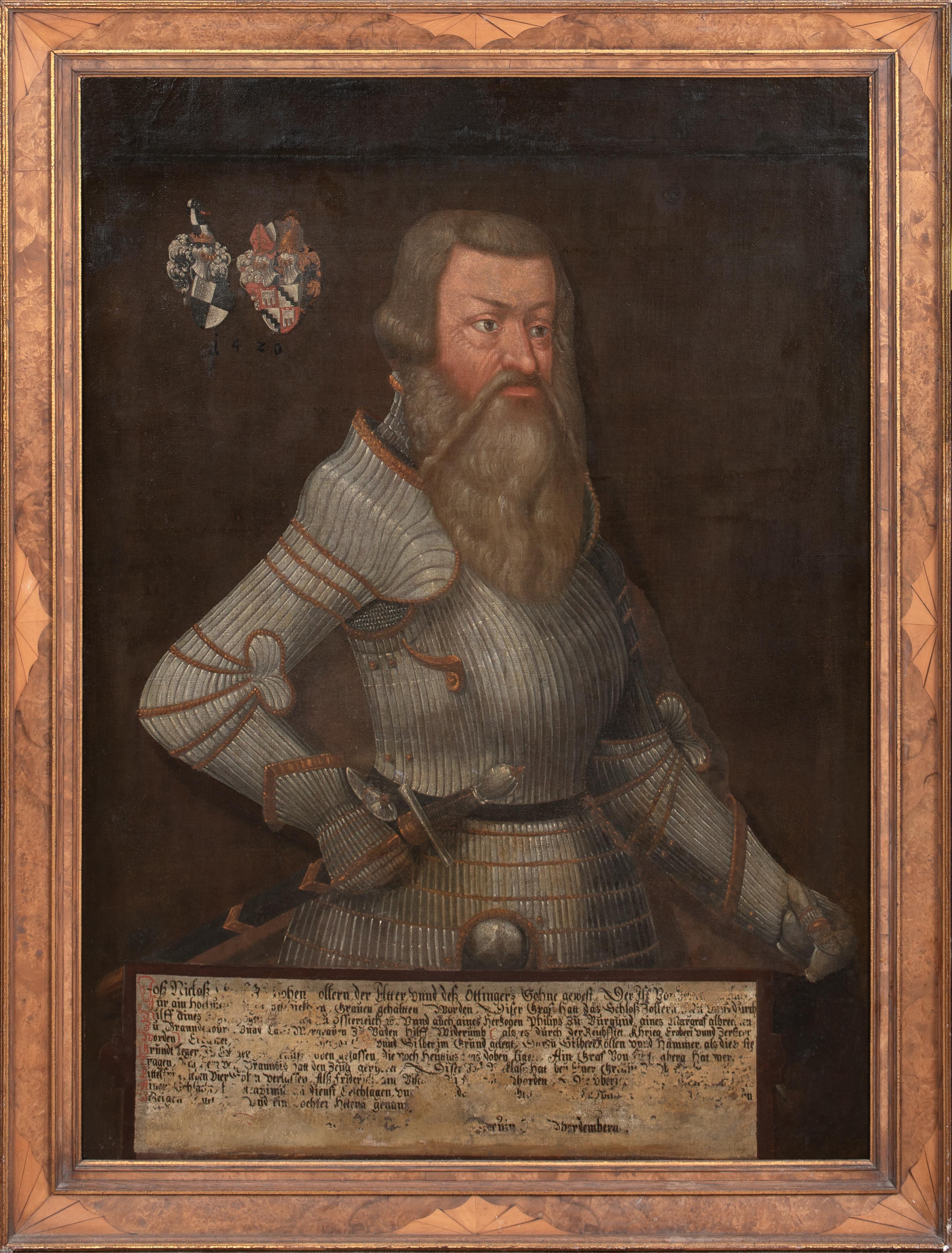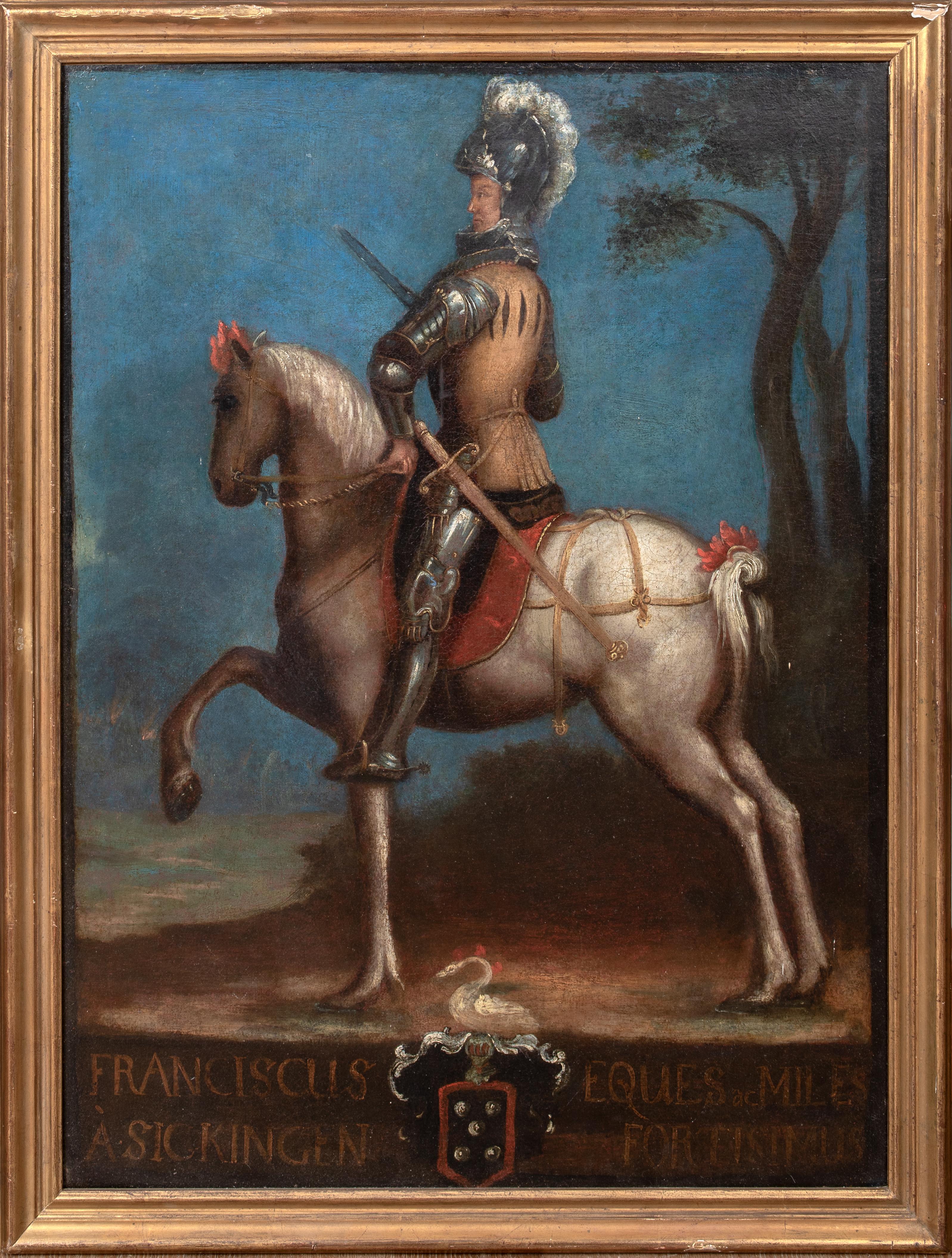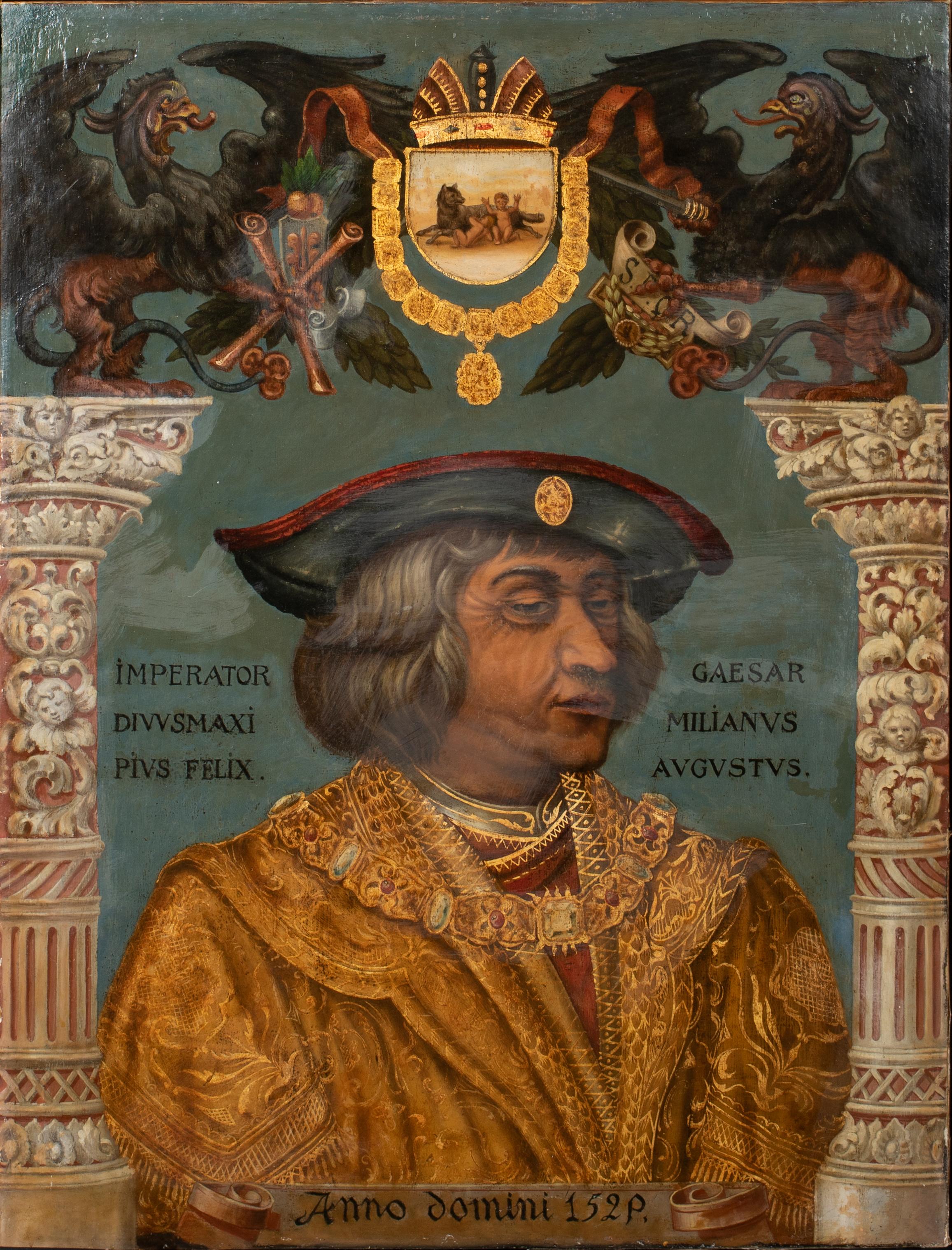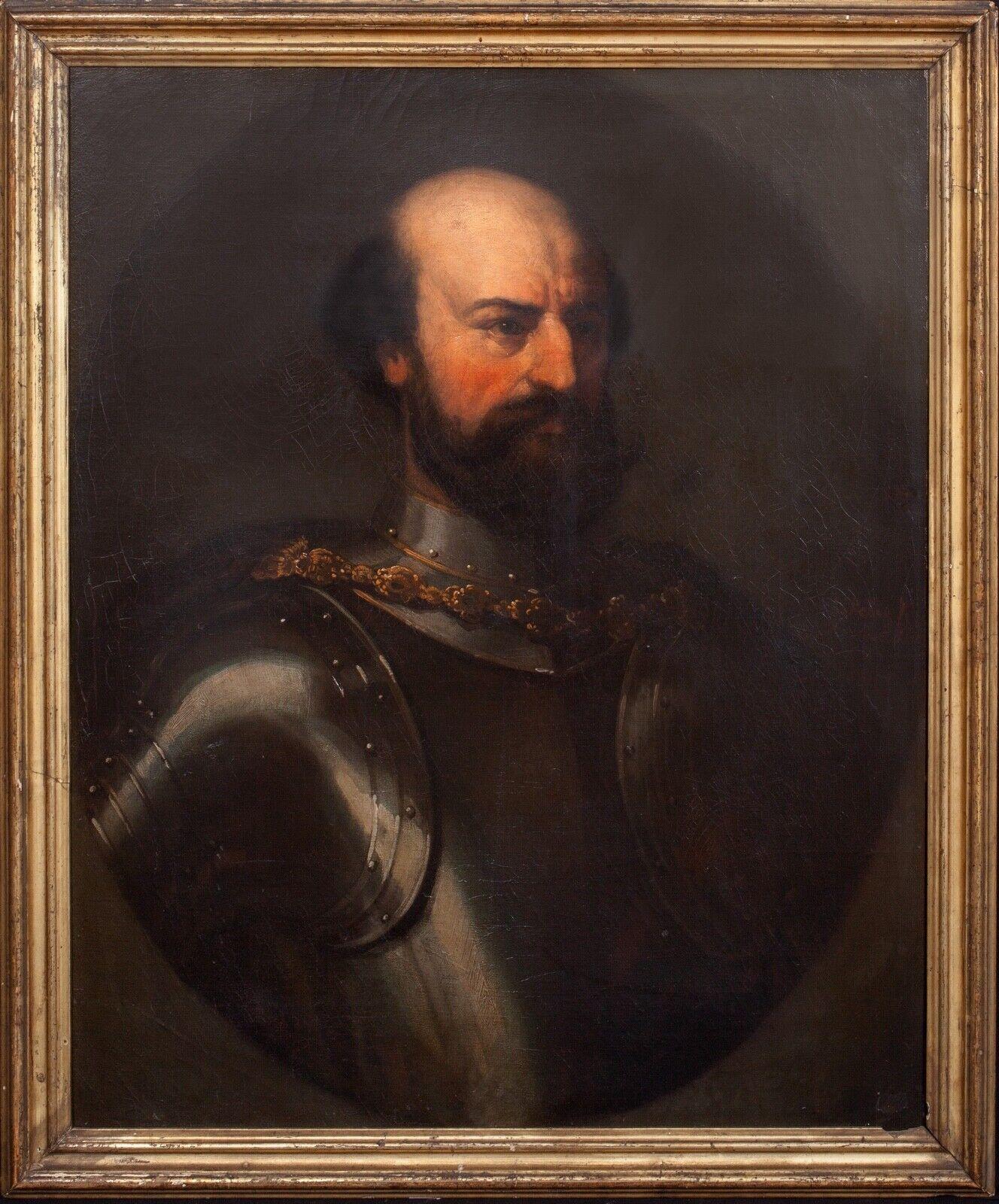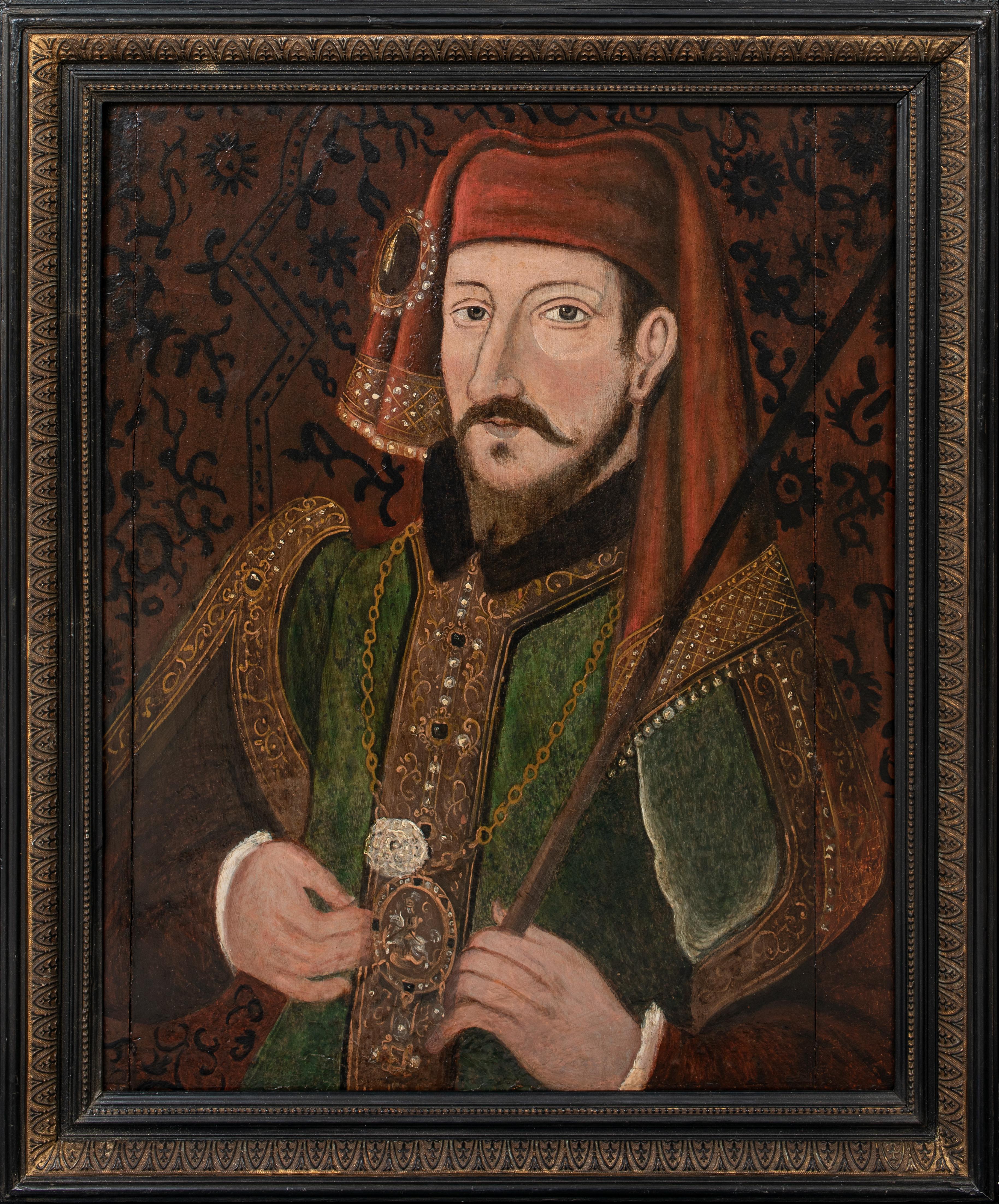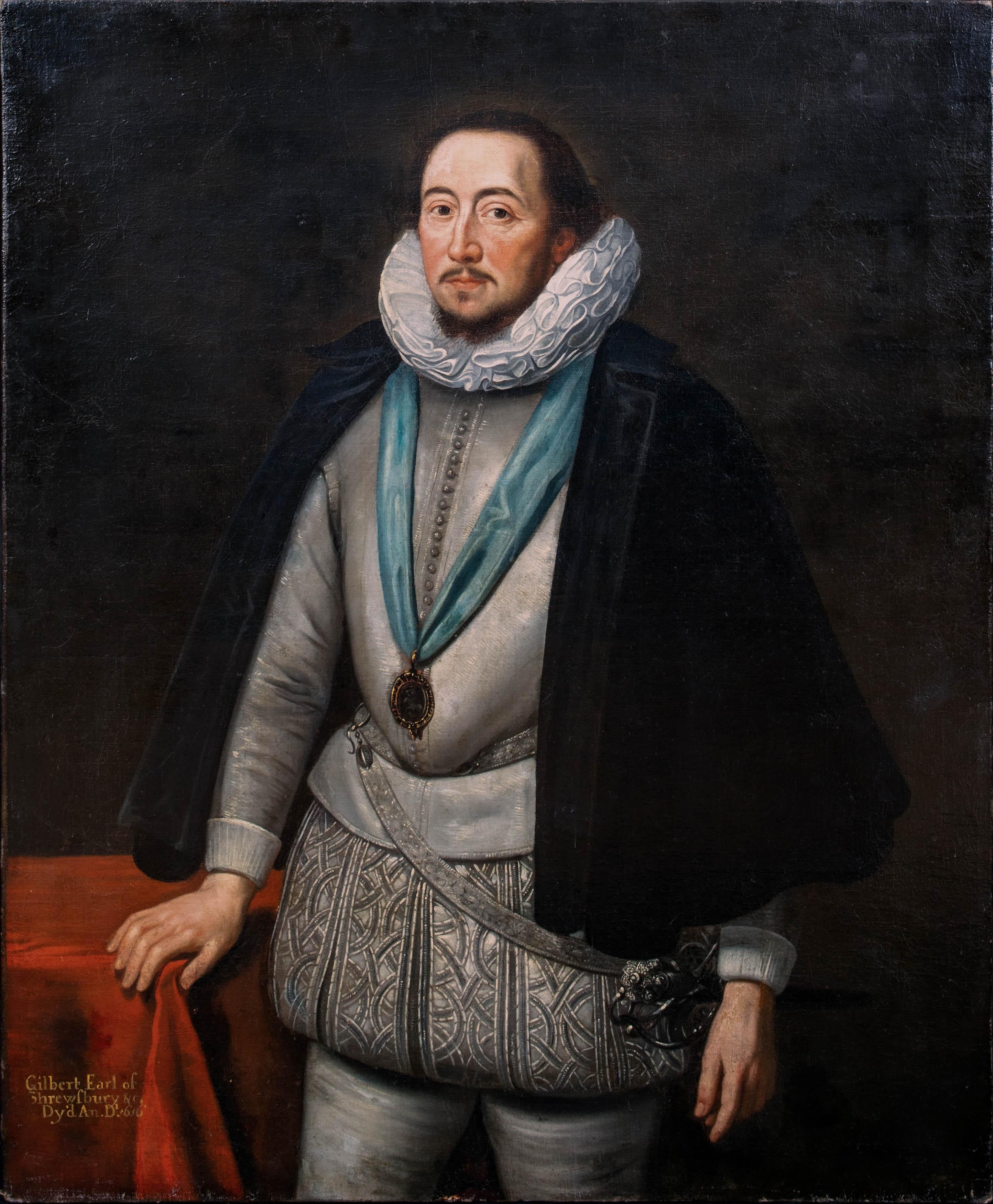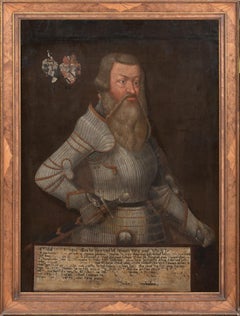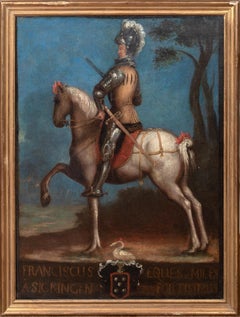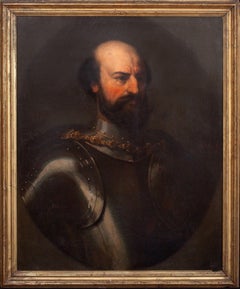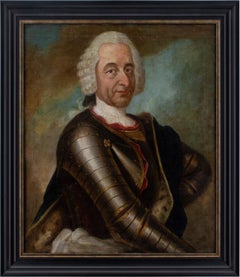Items Similar to Portrait Of Eitel Friedrich II, Count of Hohenzollern (1452-1512), 16th Century
Want more images or videos?
Request additional images or videos from the seller
1 of 11
UnknownPortrait Of Eitel Friedrich II, Count of Hohenzollern (1452-1512), 16th Century
$8,225.92
$10,282.4020% Off
£6,000
£7,50020% Off
€7,007.91
€8,759.8820% Off
CA$11,460.39
CA$14,325.4920% Off
A$12,473.25
A$15,591.5620% Off
CHF 6,548.34
CHF 8,185.4220% Off
MX$150,695.02
MX$188,368.7720% Off
NOK 82,188.92
NOK 102,736.1520% Off
SEK 77,494.43
SEK 96,868.0420% Off
DKK 52,313.39
DKK 65,391.7320% Off
About the Item
Portrait Of Eitel Friedrich II, Count of Hohenzollern (1452-1512), 16th Century
German School Court Portrait
Large 16th Century German Old Master portrait identified as Eitel Frederich II, Count of Hohenzollern, oil on canvas. Excellent quality half length portrait with Hohenzollern coat of arms and dated 1495 marking the appointment of Frederich as judge of the Holy Roman Empire by Maximilian I. Presented in a hand inlaid maple wood frame. Faint remainder of inscription at the bottom. Unsigned
Measurements: 53" x 40" framed approx
- Dimensions:Height: 50 in (127 cm)Diameter: 43 in (109.22 cm)
- Medium:
- Period:
- Condition:
- Gallery Location:Blackwater, GB
- Reference Number:Seller: 7832951stDibs: LU1577216999312
About the Seller
4.9
Vetted Professional Seller
Every seller passes strict standards for authenticity and reliability
Established in 2008
1stDibs seller since 2021
297 sales on 1stDibs
Typical response time: 1 hour
- ShippingRetrieving quote...Shipping from: Blackwater, United Kingdom
- Return Policy
Authenticity Guarantee
In the unlikely event there’s an issue with an item’s authenticity, contact us within 1 year for a full refund. DetailsMoney-Back Guarantee
If your item is not as described, is damaged in transit, or does not arrive, contact us within 7 days for a full refund. Details24-Hour Cancellation
You have a 24-hour grace period in which to reconsider your purchase, with no questions asked.Vetted Professional Sellers
Our world-class sellers must adhere to strict standards for service and quality, maintaining the integrity of our listings.Price-Match Guarantee
If you find that a seller listed the same item for a lower price elsewhere, we’ll match it.Trusted Global Delivery
Our best-in-class carrier network provides specialized shipping options worldwide, including custom delivery.More From This Seller
View AllPortrait Of Eitel Friedrich II, Count of Hohenzollern (1452-1512), 16th Century
Located in Blackwater, GB
Portrait Of Frederick I, Elector Of Brandenburg Knight Of Hohenzollern 1420, 16th Century
German School Court Portrait
Large 16th Century German Old Master portrait identified as F...
Category
16th Century Portrait Paintings
Materials
Canvas, Oil
$8,225 Sale Price
20% Off
Portrait Of Franz von Sickingen Knight Of The Holy Roman Empire (1481-1523)
Located in Blackwater, GB
Portrait Of Franz von Sickingen Knight Of The Holy Roman Empire (1481-1523)
Italian School
Large 16th/17th Century Italian Old Master portrait of Franz von Sickingen, Knight Of The...
Category
17th Century Portrait Paintings
Materials
Canvas, Oil
$6,580 Sale Price
20% Off
Portrait Of Maximilian I Holy Roman Emperor & Archduke of Austria, 17th Century
Located in Blackwater, GB
Portrait Of Maximilian I Holy Roman Emperor & Archduke of Austria, 17th Century
follower of Giulio Romano (1492-1546)
Fine large 16th Century Italian S...
Category
17th Century Portrait Paintings
Materials
Oil, Canvas
$6,471 Sale Price
20% Off
Portrait Of Palatine Matthew III Csák of Trencin (1260-1321) Italian School
Located in Blackwater, GB
Portrait Of Palatine Matthew III Csák of Trencin (1260-1321)
Italian School - Circle of TITIAN
Large 16th Century Italian School portrait of a Matthew III Csak Of Trencin, oil on c...
Category
17th Century Portrait Paintings
Materials
Canvas, Oil
$5,374 Sale Price
20% Off
Portrait of Henry IV, King of England (1367-1413), 16th Century
Located in Blackwater, GB
Portrait of Henry IV, King of England (1367-1413), 16th Century
English School Portrait - Early Oil On Panel
Large 16th Century court portrait of Henry IV, King Of England (1367-14...
Category
16th Century Portrait Paintings
Materials
Oil, Wood Panel
$14,258 Sale Price
20% Off
Portrait Of Gilbert Talbot 7th Earl of Shrewsbury (1552-1616), 16th Century
Located in Blackwater, GB
Portrait Of Gilbert Talbot 7th Earl of Shrewsbury (1552-1616), 16th Century
Circle of George Gower (c.1540–1596)
Huge 16th Century Portrait Of Gil...
Category
18th Century Portrait Paintings
Materials
Canvas, Oil
$16,451 Sale Price
20% Off
You May Also Like
Portrait Knight Paint Oil on canvas 17th Century Lombard school Old master Italy
Located in Riva del Garda, IT
Lombard painter of the 17th century
Portrait of a Knight in Armour
Oil on canvas
81 x 70 cm./ Framed 93 x 82
A handsome gentleman in armour, immortalised in an authoritative and pr...
Category
17th Century Old Masters Paintings
Materials
Oil
$6,101 Sale Price
20% Off
Mid-18th-Century German School, Portrait Of An Aristocrat In Armour
Located in Cheltenham, GB
This mid-18th-century half-length German portrait depicts a middle-aged aristocrat wearing armour and a wig.
Despite his heavily-clad appearance, it’s likely that this rather noncha...
Category
1750s Old Masters Portrait Paintings
Materials
Canvas, Oil
Portrait of William Herbert, 3rd Earl of Pembroke, Early 17th Century Portrait
Located in London, GB
English School, (circa 1600)
Portrait of William Herbert, 3rd Earl of Pembroke
Oil on panel, oval
Image size: 29¼ x 23⅞ inches
Painted wooden frame
Provenance:
176, Collection of Francis Greville, 1st Earl of Warwick.
The Trustees of the Lord Brooks’ Settlement, (removed from Warwick Castle).
Sotheby’s, London, 22nd March 1968, lot 81.
Painted onto wooden panel, this portrait shows a dark haired gentleman in profile sporting an open white shirt. On top of this garments is a richly detailed black cloak, decorated with gold thread and lined with a sumptuous crimson lining. With the red silk inside it’s all very expensive and would fall under sumptuary laws – so this is a nobleman of high degree.
It’s melancholic air conforms to the contemporary popularity of this very human condition, evident in fashionable poetry and music of the period. In comparison to our own modern prejudices, melancholy was associated with creativity in this period.
This portrait appeared in the earliest described list of pictures of Warwick castle dating to 1762. Compiled by collector and antiquary Sir William Musgrave ‘taken from the information of Lord & Lady Warwick’ (Add. MSS, 5726 fol. 3) is described;
‘8. Earl of Essex – an original by Zuccharo – seen in profile with black hair. Holding a black robe across his breast with his right hand.’
As tempting as it is to imagine that this is a portrait of Robert Devereux, the 2nd Earl Essex, we might take this with a pinch of salt. Its identification with this romantic and fatal Elizabethan might well have been an attempt to add romance to Warwick Castle’s walls. It doesn’t correspond all that well with Essex’s portraits around 1600 after his return from Cadiz. Notably, this picture was presumably hung not too far away from the castle’s two portraits of Queen Elizabeth I. The first, and undoubtedly the best, being the exquisite coronation portrait that was sold by Lord Brooke in the late 1970s and now hangs in the National Portrait Gallery. The second, described as being ‘a copy from the original at Ld Hydes’, has yet to resurface.
The portrait eventually ended up being hung in the State Bedroom of Warwick Castle.
Archival documents present one other interesting candidate. The Greville family’s earliest inventory of paintings, made in 1630 at their home Brooke House in Holborn, London, describes five portraits of identified figures. All five belonged to the courtier, politician and poet Sir Fulke Greville (1554-1628), 1st Baron Brooke, and were hung in the ‘Gallerie’ of Brooke House behind yellow curtains. One of them was described as being of ‘Lord of Pembrooke’, which is likely to have been William Herbert (1580-1630), 3rd Earl of Pembroke. William was the eldest son of Greville’s best friend’s sister Mary Sidney, and was brought up in the particularly literary and poetically orientated household which his mother had supported. Notably, the 3rd Earl was one of the figures that Shakespeare’s first folio was dedicated to in 1623.
The melancholic air to the portrait corresponds to William’s own pretensions as a learned and poetic figure. The richness of the robe in the painting, sporting golden thread and a spotted black fabric, is indicative of wealth beyond that of a simple poet or actor. The portrait’s dating to around the year 1600 might have coincided with William’s father death and his own rise to the Pembroke Earldom. This period of his life too was imbued with personal sadness, as an illicit affair with a Mary Fitton had resulted in a pregnancy and eventual banishment by Elizabeth I to Wilton after a short spell in Fleet Prison. His illegitimate son died shortly after being born. Despite being a close follower of the Earl of Essex, William had side-stepped supporting Devereux in the fatal uprising against the Queen and eventually regained favour at the court of the next monarch James I.
His linen shirt is edged with a delicate border of lace and his black cloak is lined on the inside with sumptuous scarlet and richly decorated on the outside with gold braid and a pattern of embroidered black spots.
Despite the richness of his clothes, William Herbert has been presented in a dishevelled state of semi-undress, his shirt unlaced far down his chest with the ties lying limply over his hand, indicating that he is in a state of distracted detachment. It has been suggested that the fashion for melancholy was rooted in an increase in self-consciousness and introspective reflection during the late 16th and early 17th centuries.
In contemporary literature melancholy was said to be caused by a plenitude of the melancholy humor, one of the four vital humors, which were thought to regulate the functions of the body. An abundance of the melancholia humor was associated with a heightened creativity and intellectual ability and hence melancholy was linked to the notion of genius, as reflected in the work of the Oxford scholar Robert Burton, who in his work ‘The Anatomy of Melancholy’, described the Malcontent as ‘of all others [the]… most witty, [who] causeth many times divine ravishment, and a kind of enthusiamus… which stirreth them up to be excellent Philosophers, Poets and Prophets.’ (R. Burton, The Anatomy of Melancholy, London, 1621 in R. Strong, ‘Elizabethan Malady: Melancholy in Elizabethan and Jacobean Portraits’, Apollo, LXXIX, 1964).
Melancholy was viewed as a highly fashionable affliction under Elizabeth I, and her successor James I, and a dejected demeanour was adopted by wealthy young men, often presenting themselves as scholars or despondent lovers, as reflected in the portraiture and literature from this period. Although the sitter in this portrait is, as yet, unidentified, it seems probable that he was a nobleman with literary or artistic ambitions, following in the same vain as such famous figures as the aristocratic poet and dramatist, Edward de Vere...
Category
Early 17th Century Old Masters Portrait Paintings
Materials
Oil, Wood Panel
Frederick III Cranach Rohrich Paint Oil on table 19th Century Flemish Portrait
Located in Riva del Garda, IT
Follower of Lucas Cranach I (Kronach, 1472 - Weimar, 1553)
Attributed to Franz Wolfgang Rohrich (Nuremberg 1787 - 1834)
Frederick III of Saxony, called the Wise (1486-1525)
Oil on ...
Category
19th Century Old Masters Portrait Paintings
Materials
Oil
$8,467 Sale Price
20% Off
Early 17th-Century Dutch School, Portrait Of A Swedish Officer
Located in Cheltenham, GB
This heavily-inscribed early 17th-century half-length portrait depicts an officer wearing a silk doublet with a gorget, presented in a feigned oval. He’s standing alongside an anchor...
Category
17th Century Baroque Portrait Paintings
Materials
Canvas, Oil
Portrait of an Officer, Cornelius Johnson, 17th Century Old Masters
By Cornelius Johnson
Located in London, GB
Circle of Cornelius Johnson
Circa 1620’s
Portrait of a Officer
Oil on canvas
Image size: 28 x 24 inches
Period style hand made frame
Provenance
Private European Estate
This striking portrait dates to around 1620, as you can see from the images of the sash the detail is very high. The sash is decorated with gold thread and would have cost a small fortune at the time. Sashes were originally developed for a military function (making officers more visible for their men during combat), but soon became a primarily male fashion...
Category
Early 17th Century Old Masters Portrait Paintings
Materials
Oil
